Overview
Waist size changes can be attributed to a combination of factors, including lifestyle choices, hormonal changes, and demographic variables, with unhealthy eating habits and inactivity being prominent contributors. The article supports this by presenting research that links high-calorie diets and sedentary lifestyles to increased waist circumferences, alongside evidence that highlights the health risks associated with an expanding waistline, thus emphasizing the importance of monitoring and managing waist size for overall health.
Introduction
In an age where health and wellness take center stage, understanding the factors influencing waist size changes is more crucial than ever. From lifestyle choices and dietary habits to hormonal fluctuations and stress levels, a myriad of elements contribute to this important health metric. Research indicates a worrying trend: waist circumference is on the rise, particularly among younger adults, signaling potential health risks associated with obesity and chronic diseases.
As the conversation around waist size evolves, so does the need for effective strategies to manage it. This article delves into the complexities of waist size changes, exploring the underlying causes, associated health risks, and practical approaches to achieving a healthier waistline—empowering individuals to make informed decisions about their health and well-being.
Understanding Waist Size Changes: An Overview
When considering why did my waist get wider, it's important to note that alterations in midsection size can be attributed to a variety of factors, including lifestyle choices, physiological changes, and demographic variables. Longitudinal studies reveal a concerning trend: circumference tends to increase over time, with younger adults experiencing more significant gains compared to older populations. For instance, the Charleston Heart Study estimates that abdominal circumferences increase by 2.8 to 7.5 cm over 25 years, averaging between 0.11 to 0.3 cm per year.
This highlights the significance of tracking body measurements, particularly in relation to obesity and related risks. The report, Recommendations for Waist Measurement in Clinical Practice, advocates for healthcare professionals to routinely incorporate waist circumference measurements alongside traditional metrics like weight and height. Such assessments are crucial for better understanding obesity's implications for cardiovascular disease (CVD) risk, particularly as recent findings suggest that even after adjusting for hypertension, diabetes, and hypercholesterolemia, those in the highest quartile of waist-to-height ratio still face significant health risks.
This is further supported by news indicating that the hazard ratios for CVD among these individuals remain significant. Furthermore, expert insights indicate that hormonal changes also contribute to fluctuations in girth, as noted by Sorensen, who stated, 'Studies using other forms of hormone replacement in women have found similar results.' By acknowledging the multifaceted influences—such as diet, physical activity levels, hormonal shifts, and stress—individuals can better navigate their health decisions and understand why did my waist get wider.
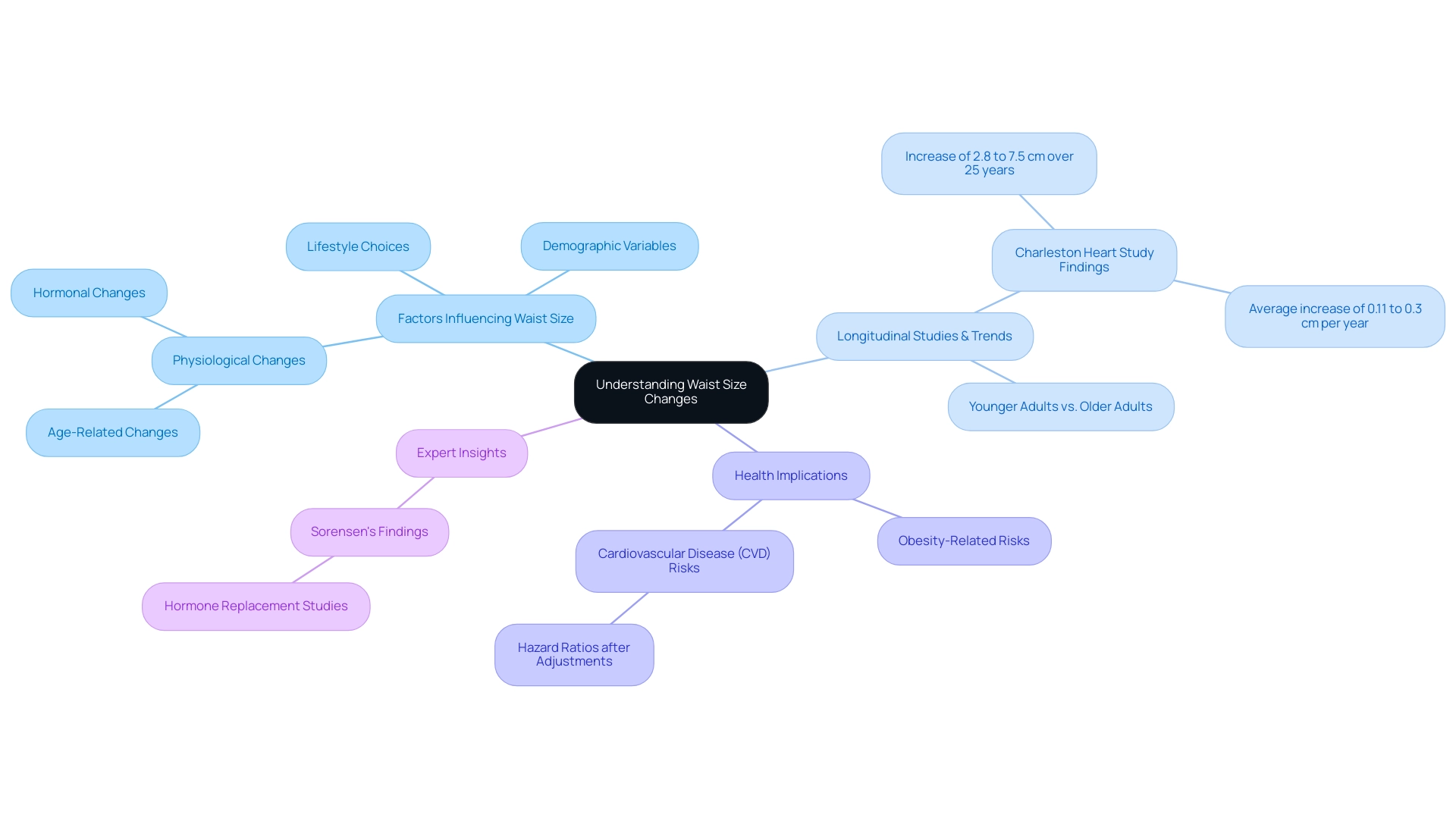
Key Factors Contributing to Waist Size Increase
Various elements contribute greatly to the growth of midsection measurements, leading to questions about why did my waist get wider, with unhealthy eating habits and inactive lifestyles being prominent. Current research reveals that high-calorie diets, particularly those rich in processed foods, provide insight into why did my waist get wider, as they are correlated with weight gain concentrated around the midsection. The Baltimore Longitudinal Study of Aging, which involved 459 healthy men and women, indicates that dietary patterns—where higher scores reflect improved diet quality—are linked to chronic disease prevention and thus influence body size.
Significantly, a study concentrating on post-menopausal women showed that a mere 10% rise in dietary pattern scores led to a smaller increase in girth over three years. As stated in the study, 'Among a large, ethnically diverse group of postmenopausal women, our study finds that improved adherence to healthful dietary patterns could help explain why did my waist get wider with smaller gains in abdominal circumference.' This discovery highlights the significance of dietary quality in controlling body measurements effectively.
Additionally, statistics show that consuming meals prepared away from home is associated with an odds ratio (OR) of 1.67 for obesity among women, prompting the question of why did my waist get wider in relation to dietary choices. As people age, they often experience a slowdown in metabolic rates, which can facilitate fat accumulation. Compounding these issues are external factors such as stress and inadequate sleep, which can lead to unhealthy eating habits and hormonal imbalances that further promote weight gain, leaving many to question why did my waist get wider.
At Foresight Wellness Coaching, we enable people and organizations to address these challenges through our extensive wellness coaching services. Our tailored programs include:
- Personalized fitness coaching
- Nutritional guidance
- Wellness workshops delivered through an app-based format that promotes lasting lifestyle changes
Furthermore, our corporate membership options offer organizations the ability to support employee wellness initiatives, fostering healthier workplace environments.
Our wellness workshops offer interactive sessions that not only inform participants on effective strategies for managing body measurements but also promote community-building among employees. Recognizing and comprehending these interconnected elements, along with the assistance of our professional coaching, allows individuals to adopt proactive strategies for managing their measurements, improving their overall health and aesthetic objectives.
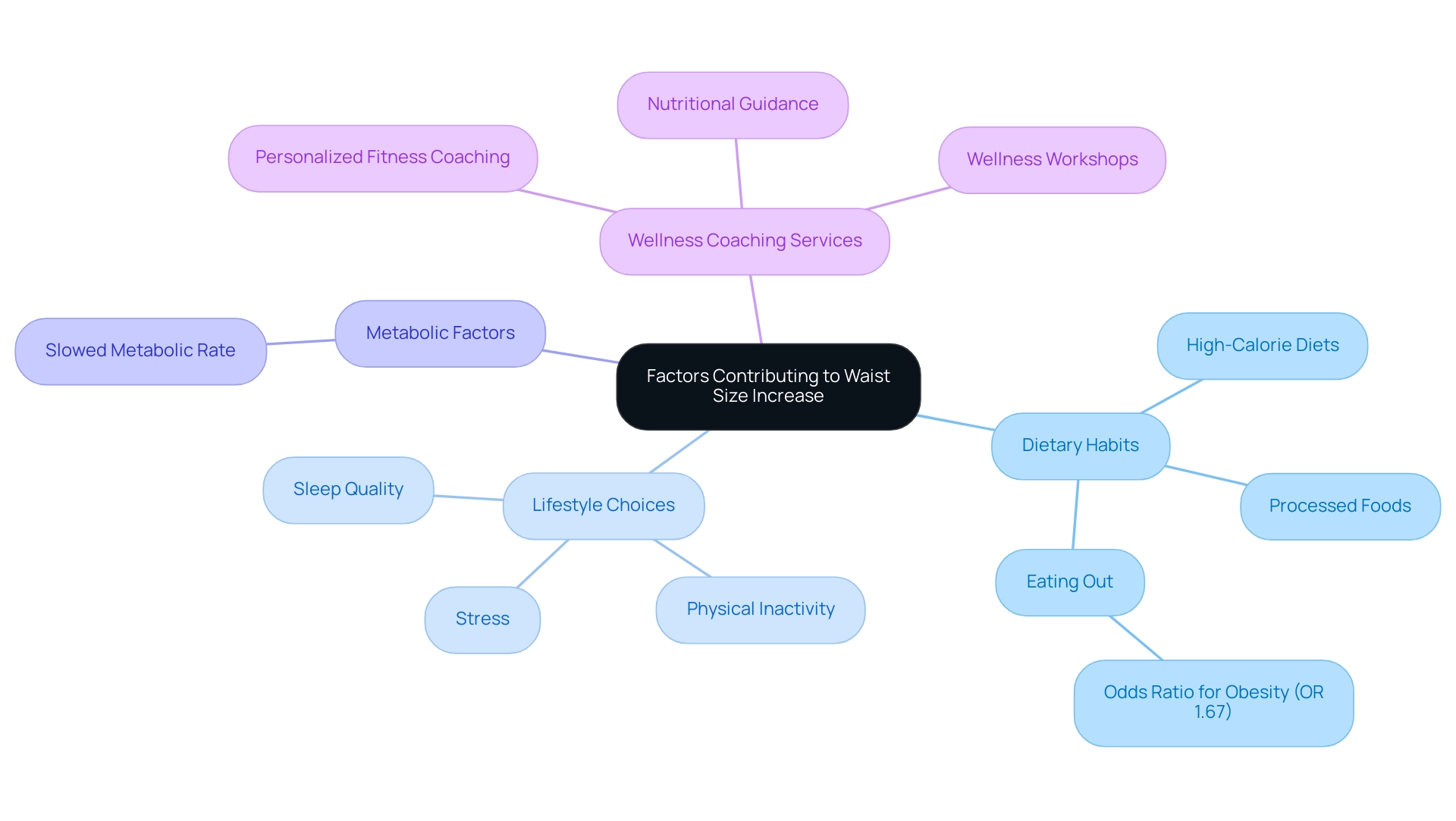
The Impact of Muscle Gain on Waist Measurement
While an increase in girth is commonly attributed to fat gain, it is essential to understand why did my waist get wider, as it may also be significantly influenced by muscle gain, particularly through strength training. Engaging in strength training can lead to an increase in muscle mass, prompting the question of why did my waist get wider initially. However, this change is often accompanied by a decrease in body fat percentage, contributing to a healthier overall body composition.
This interplay highlights the importance of looking beyond mere numerical values on the scale and focusing on holistic health. Recent studies, including one that examined the relationship between Body Mass Index (BMI) and Waist Circumference (WC) in older adults, revealed that while BMI showed a stronger correlation with tissue masses than WC, people with similar BMI and WC values exhibited significant differences in tissue mass proportions. Such findings underscore the necessity for cautious clinical interpretation when assessing body composition, particularly in light of the variations in tissue mass that can exist.
Additionally, as noted by Haojing Zhou, the correlation of Waist-to-Height Ratio (WHR) with grip strength remained consistent across age groups and obesity levels, reinforcing the idea that midsection measurement is not solely an indicator of fat gain but is also influenced by muscle development. This correlation indicates that as people participate in strength training, they may question why did my waist get wider, as their midsection measurements may not precisely represent their body composition changes resulting from muscle growth. Moreover, it is important to note that an inflection point of 9.486 cm/√kg for the Waist-to-Height Index (WHI) has been established, above which it is positively related to testosterone deficiency.
Grasping this connection enables people to prioritize thorough wellness strategies instead of concentrating exclusively on size.
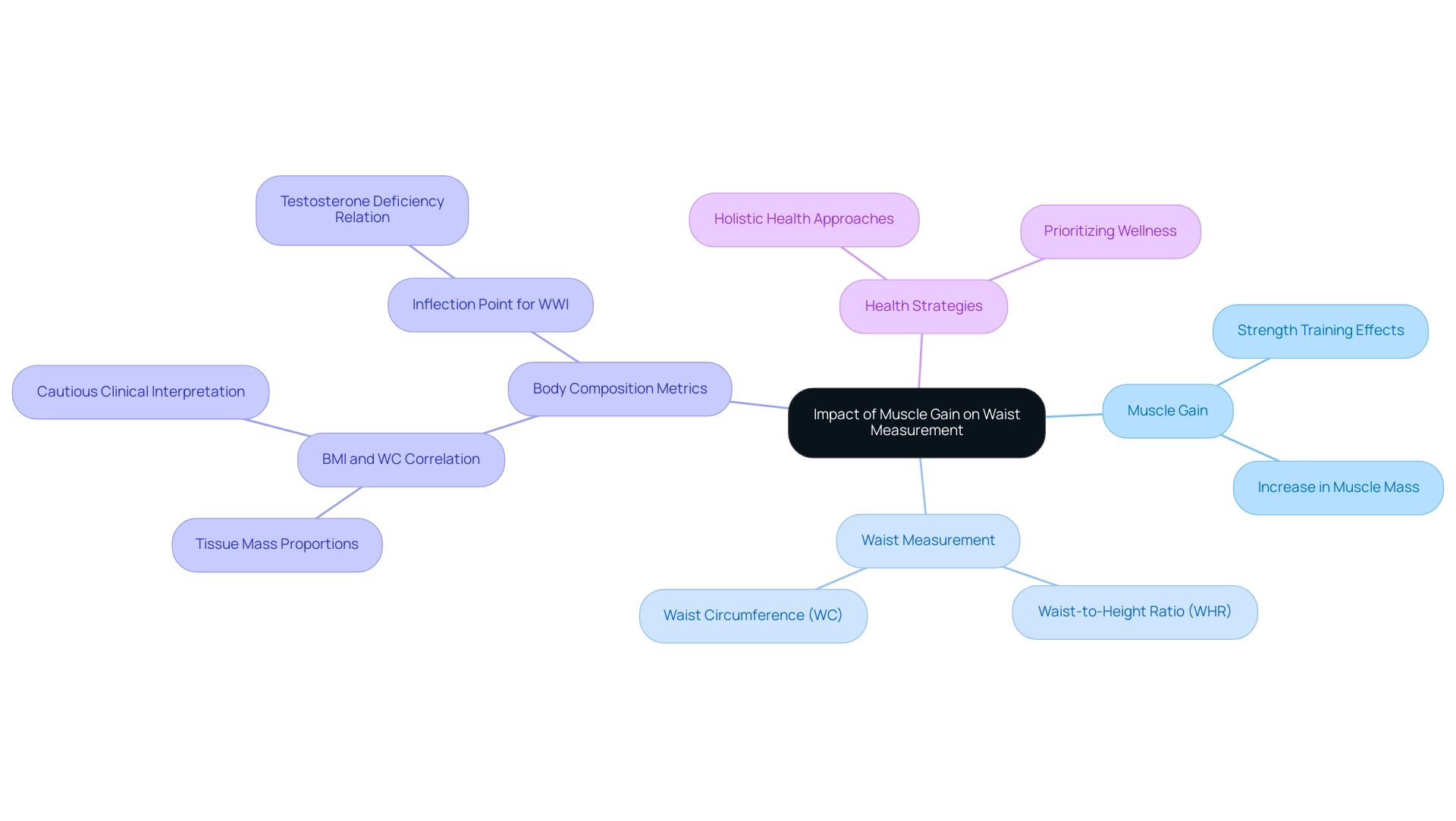
Health Risks Associated with an Expanding Waistline
The question of why did my waist get wider is closely correlated with an increase in visceral fat, which presents substantial risks to well-being. Research highlights that excess abdominal fat significantly raises the likelihood of developing chronic conditions such as heart disease, diabetes, and certain cancers. A systematic review of studies conducted between 2009 and 2019 has identified various health risks associated with high circumference around the abdomen, including:
- Hypertension
- Diabetes
- Joint pain
- Metabolic syndrome—a combination of conditions that amplifies the risk of heart disease and stroke.
Significantly, an extensive study involving 14,924 adult participants from the third National Health and Nutrition Examination Survey highlights these findings, showing that people with larger circumferences are at a higher risk for these chronic diseases. Additionally, the case study titled 'Vulnerability to Visceral Fat Accumulation' reveals that genetic, ethnic, and sex factors significantly influence the likelihood of accumulating visceral fat, with certain populations, such as Native Americans and Pima Indians, being more susceptible. In contrast, Mediterranean populations show lower rates of visceral fat accumulation and related cardiovascular issues.
Comprehending these essential risks can enable people to adopt proactive strategies in managing their body dimensions. As Pischon and associates observed, their study on the relationships between body mass index (BMI), midsection measurement, and mortality risk among 359,387 adults in nine nations emphasizes the importance of discussing this aspect in health conversations. By understanding why did my waist get wider, individuals can be motivated to adopt healthier lifestyle choices.
Furthermore, calculations and model creations for these studies were performed using SAS version 9.4, which adds credibility to the research methods discussed.
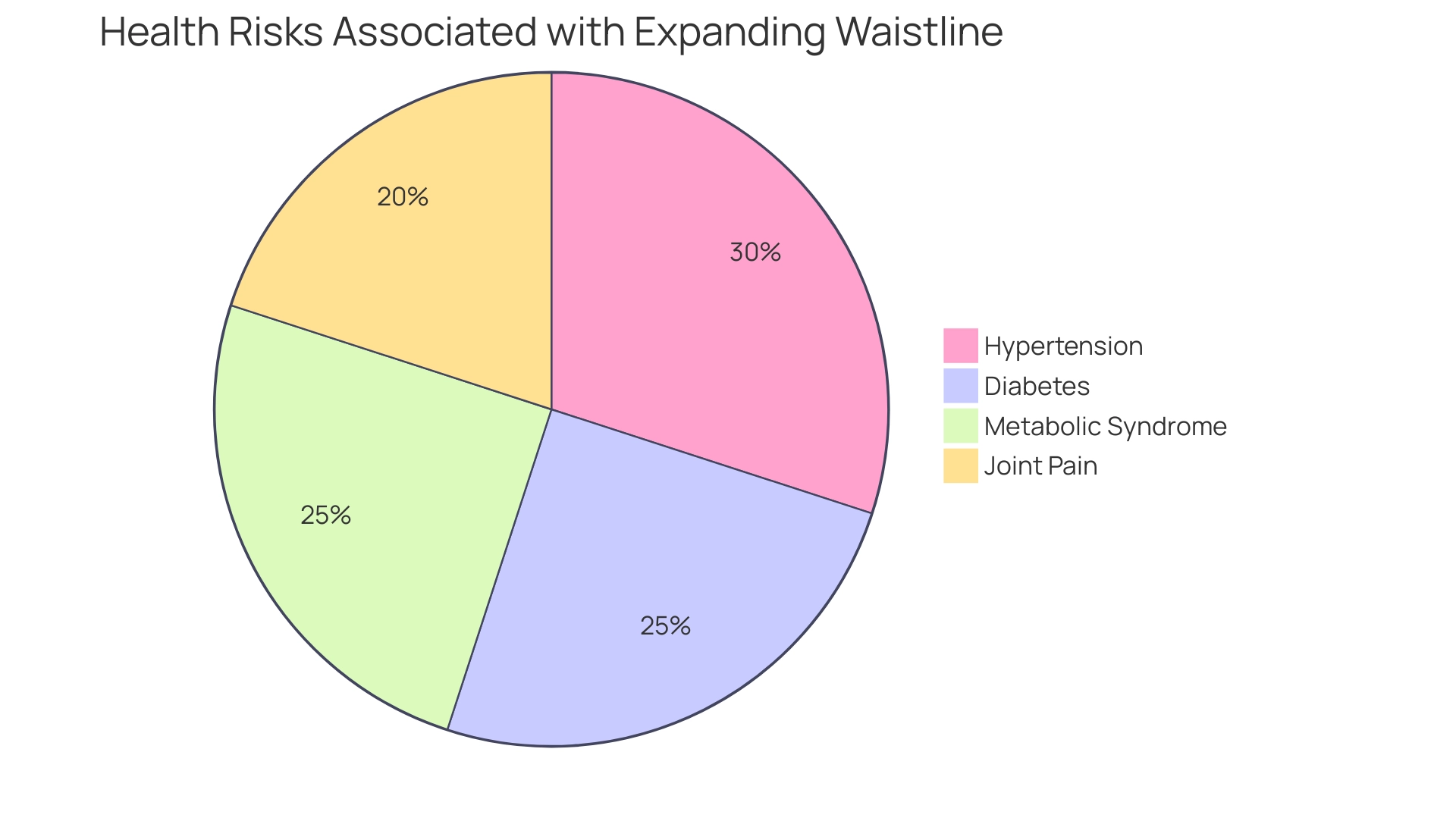
Effective Strategies to Manage and Reduce Waist Size
Effective management and reduction of body size hinge on the adoption of several key strategies, which can be significantly enhanced through tailored corporate wellness programs. A balanced diet, rich in whole foods, fruits, and vegetables, plays a crucial role in influencing body measurements while minimizing the intake of processed foods. Recent statistics indicate that the prevalence of abdominal obesity, characterized by a waist circumference exceeding 88 cm, has reached a concerning 65%, underscoring the need for effective dietary interventions.
This view of obesity treatment will radically expand the number of individuals who may need to be considered as candidates for weight loss interventions, as noted by A Merchant. Regular physical activity, including personalized exercise regimens designed by dedicated health coaches, is essential for burning calories and building muscle mass. The incorporation of structured workout programs designed for muscle gain, weight loss, and endurance can significantly enhance overall fitness and size management.
Our customized app supports these initiatives, providing users with easy access to their personalized plans and progress tracking. In a notable case study examining the '4 Phases Method for Weight Reduction,' participants experienced significant reductions in weight, BMI, and girth, highlighting the method's efficacy across various age groups. Furthermore, it is important to recognize that obesity results from a complex interplay of genetic predisposition and environmental factors, which can affect personal responses to diet and exercise.
Integrating stress management techniques, such as mindfulness practices and ensuring adequate sleep, is also vital for understanding why did my waist get wider; these techniques are seamlessly incorporated into our wellness programs to provide holistic support. By adopting these comprehensive strategies within a corporate wellness framework, individuals can progress toward their health goals while enhancing overall well-being and productivity.
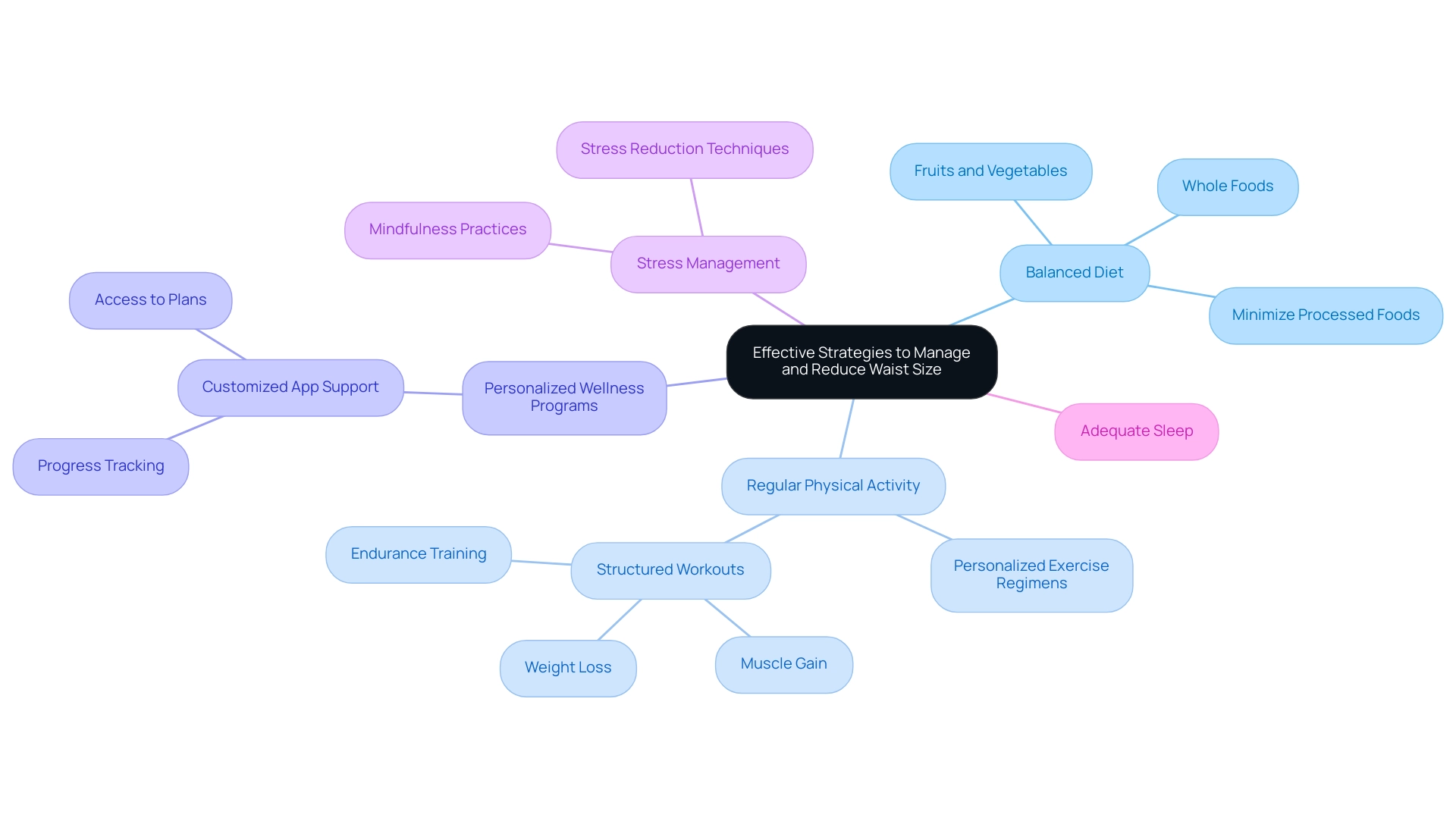
Conclusion
Understanding the complexities surrounding waist size changes is essential for promoting better health outcomes. The factors influencing waist size are diverse, ranging from dietary choices and physical activity levels to hormonal fluctuations and stress. As research indicates, the rising trend in waist circumference, particularly among younger adults, highlights the urgent need for awareness and proactive management of this health metric.
Effective strategies for managing waist size involve a holistic approach, including improved dietary habits, regular physical activity, and stress management techniques. By prioritizing a balanced diet rich in whole foods and engaging in strength training, individuals can foster healthier body compositions while addressing the risks associated with excess abdominal fat. The importance of tailored wellness programs cannot be overstated, as they provide the necessary support and resources for individuals to make sustainable lifestyle changes.
Ultimately, recognizing waist size as a significant health indicator empowers individuals to take charge of their well-being. By understanding the underlying causes and implementing effective strategies, it is possible to mitigate health risks and promote a healthier lifestyle. Taking action today can lead to a brighter, healthier future, where informed decisions about waist size contribute to overall health and wellness.
Frequently Asked Questions
What factors can cause my waist to get wider?
Waist size can increase due to lifestyle choices, physiological changes, and demographic variables. Key contributors include unhealthy eating habits, inactive lifestyles, hormonal changes, and external factors like stress and inadequate sleep.
How does age affect waist circumference?
Longitudinal studies indicate that waist circumference tends to increase over time, with younger adults experiencing more significant gains compared to older populations. For example, the Charleston Heart Study estimates an increase of 2.8 to 7.5 cm in abdominal circumference over 25 years.
Why is tracking waist measurements important?
Tracking waist measurements is crucial for understanding obesity and its related health risks, particularly cardiovascular disease (CVD). Waist circumference measurements should be taken alongside traditional metrics like weight and height for a comprehensive health assessment.
What role does diet play in waist size changes?
Dietary habits significantly influence waist size. High-calorie diets, especially those rich in processed foods, are correlated with weight gain around the midsection. Improved adherence to healthful dietary patterns can help mitigate increases in abdominal circumference.
How does meal preparation location affect waist size?
Statistics show that consuming meals prepared away from home is associated with a higher risk of obesity. For women, the odds ratio for obesity increases to 1.67 when eating out frequently.
Are there specific studies that support these findings about waist size and diet?
Yes, the Baltimore Longitudinal Study of Aging found that better dietary patterns are linked to chronic disease prevention and influence body size. Additionally, a study focused on post-menopausal women indicated that a 10% increase in dietary pattern scores resulted in smaller increases in waist circumference over three years.
How do hormonal changes affect waist size?
Hormonal changes can lead to fluctuations in waist size. Studies have shown that hormone replacement therapies in women can impact body measurements, indicating that hormonal shifts are a significant factor.
What external factors contribute to waist size changes?
External factors such as stress and inadequate sleep can lead to unhealthy eating habits and hormonal imbalances, further promoting weight gain and increasing waist size.
How can wellness coaching help individuals manage waist size?
Wellness coaching services, such as personalized fitness coaching and nutritional guidance, can help individuals adopt proactive strategies for managing their waist size and improving overall health. Programs may include interactive workshops that promote lasting lifestyle changes.

